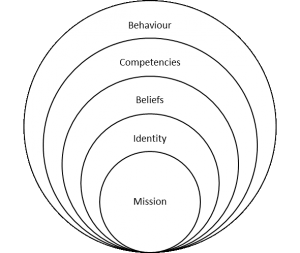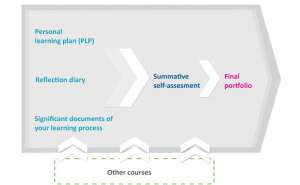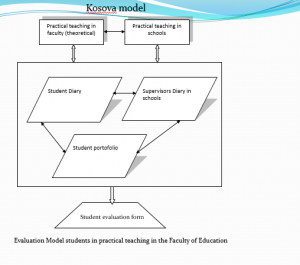Portfolio as a Tool for Teachers’ Reflective Thinking and Professional Identity Development
Authors: Dr. Eila Burns and Prof.Asoc. Dr. Kastriot Buza|
The purpose of this presentation paper is to discuss whether teacher trainees’ portfolios demonstrated evidence of reflective thinking on the different aspects of teachers’ performance. An investigation onto teacher trainees’ portfolios was conducted in teacher education in Kosovo (University of Pristina, Faculty of Education) and in Finland (JAMK University of Applied Sciences, Teacher Education). This investigation was a part of the activities in the EU Funded TEMPUS Project “Modernizing Teacher Education at University of Prishtina”. The paper was presented at the Teacher Conference in Pristina in 2015. We used Korthagen’s (2004) model as a theoretical frame to analyse outcomes of 10 teacher trainees’ portfolios. The analysis of written portfolios revealed that the students prompted reflective thinking in many, but not all, dimensions of teachers’ work. Teacher trainees’ portfolios suggest that their thinking seems to be oriented towards the areas of skills and competencies, rather than on the dimensions of beliefs and internal teacher identity. The paper suggests that teacher education institutions should plan portfolios not as simple collection of artefacts but rather a core part of developing teachers’ professional identity.
Introduction
The importance of reflection relating to one’s practices has been emphasized in teacher education programmes. However, it is not always clear what teachers should reflect upon within the context of their professional identity development. Already at the beginning of the decade, Klenowski (2000) argued that reflective teachers are self-directed in terms of their own professional development and have the capacity to question, frame and resolve dilemmas of classroom practice. Reflection frameworks used in teacher education programmes commonly illuminate the external elements of teaching, such as teaching skills/behaviours, and abilities/ competencies. All of which are crucial elements in teachers’ professional development. However, literature on teacher education has indicated the significance of also other more, broad range aspects of teaching skills, such as attitudes, philosophies, beliefs, professional identity and mission being important for reflection. Aspects that often are not clearly presented in the reflection framework models produced by the teacher education universities.
The model for teacher reflection developed by Korthagen (2004) is an attempt to incorporate a number of aspects that are considered to be crucial for reflection. In this small investigation, we explored teacher trainees’ portfolios in order to discover which aspects of Korthagen’s model teacher trainees reflect upon in their teacher education. We utilized the model in order to understand how teacher trainees’ could be supported to develop deeper and broader reflection skills, and thus improve their professional identity development. The model by Korthagen is not widely used in the author’s organisations, therefore we firstly explain the model briefly before moving to the other theoretical concepts.
Korthagen’s model of performance
Korthagen (2004) created his ‘onion’ model in an attempt to broaden discussion on teacher reflection. The model incorporates several aspects of teachers’ performance (Figure 1). All different levels of teacher functioning can be influenced, although only the outer levels (environment and behaviour) can be directly observed by others.
Environment
↑

The outer layers in the model, environment (i.e. educational organizations, students), behaviours (i.e. teacher’s performance) and competencies (i.e. knowledge and skills) are the levels that often are the most obvious for teacher trainees to reflect upon. Those levels are relevant parts of teaching and, thus, incorporated in many reflection frameworks. Whereas, the inner elements, such as, beliefs (i.e. teacher’s philosophies of learning and teaching), professional identity (i.e. who am I as a teacher?), and mission (giving meaning to one’s own existence, ‘why do I want to teach?), are emerging subjects to the discussion of teacher reflection and reflection frameworks.
As can be noticed from the model, the inner layers are more difficult to observe. They are related to the uniqueness of the individual teacher and are typically remained implicit. However, both inner and outer layers have been seen important and interrelated in terms of teacher performance and professional development (Korthagen, 2004; Tigelaar et al., 2006). In the process of professional teacher identity development, the research seem to suggest that all aspects of teacher’s actions should be considered and reflected upon. Korthagen (2004) suggests that the outer levels can influence the inner levels and reverse. For example, a challenging student (the environment) can elicit different reactions from a teacher than a more subtle student. And reversely, a teacher’s accepting and understanding reaction in a challenging situation can have an impact on the environment i.e. on a student’s behaviour. Korthagen (2004) suggests that the model of levels could offer a useful framework to think and discuss reflectively teachers’ professional development by clarifying a number of relevant aspects that need to be considered in the process.
In many teacher education programmes portfolios as used to promote trainee teachers reflection on their professional identities. The literature on the use of the portfolio in teacher education seems to portray its use as a tool for promoting reflective practice (e.g. Klenowski, 2002; Jaatinen, 2013; Oakley, G.; Pegrum, M. & Johnston, S., 2013). Reflective practice is often seen as a process of ‘thinking in action’, a notion that embraces a constructivist perspective toward learning and knowledge acquisition in which the individual formulates a concept of reality based on their own experiences. The reality of teachers is currently continuously changing, and teachers are required to frequently refresh and develop their skills and knowledge. The portfolio can be considered to be part of authentic assessment process that promotes and develops practitioner skills and teachers’ professional identity that are required in a current climate of teaching.
Teachers’ professional identity
Discussions about professional identity have become particularly prominent in professions relating to human-centred and creative work (Eteläpelto, 2007). In studies on teacher identity, the self has been seen as a socially negotiated process (Watson, 2006), being as a constellation of teachers’ perceptions of themselves as teachers (Beijaard et al., 2004; Lasky, 2005), and continuously reconstructed and renegotiated through daily practices and interactions (Beijaard et al., 2004). A number of studies focusing on VET teachers’ professional identity negotiation also highlight the importance of balancing the occupational identities with their teacher identities (Fejes & Köpsén 2014; Köpsén, 2014) as well as acknowledging professional agency (Vähäsantanen, 2013).
The development of teacher identity has been reported to be a highly individual process (Lahtinen & Nevgi, 2014). The fundamental changes in teacher identity do not take place easily. Reflections of one’s pedagogical decisions and practices can be difficult and sometimes painful process for some teacher trainees. Beijaard and his associates (2004) have highlighted four common features that are essential for teachers’ professional identity. Firstly, it is not understood as a stable entity. Rather it is a dynamic process of interpretation and reinterpretation of experiences. Secondly, professional identity implies both a context and a person. Thirdly, teachers’ professional identity consists of sub-identities of which some can be seen comprising the core of the identity, while others may be more peripheral. And finally, the process of professional identity negotiation requires teachers’ active involvement. Overall then, professional identity is not something teachers have but something they use in order to make sense of who they are as teachers (Beijaard et al., 2004). Working as a VET teacher means developing a professional identity and committing oneself to on-going renegotiation of one’s professional identity.
Methods
Context of the study
The collaboration between the two higher education institutions (in Kosovo and in Finland) focused on collating data to identify whether teacher trainees’ portfolios were used to stimulate reflections on the various aspects of teaching as introduced in Korthagen’s model. This investigation was qualitative and interpretive in format, and it was undertaken with the specific aim of raising issues and reviewing current practice on using portfolios in teacher education. This collaborative work was a part of the EU Funded TEMPUS Project “Modernizing Teacher Education at University of Prishtina”.
In order to achieve the aims, we collected randomly 10 teacher trainees’ final written portfolios (five in each HE institution) and analysed their content. The portfolios were complied in the academic year 2014-2015 and followed the existing instructions set by both universities. The figures below illustrate the stages how teacher portfolios are compiled at JAMK University of Applied Sciences and the University of Pristina.


Analysis
The analysis of teacher trainees’ final portfolios was aimed at identifying reflections on the different dimensions of teachers’ performance in Korthagen’s model (Korthagen, 2004). To analyse the written portfolios we utilised thematic analysis method (Braun & Clarke, 2006).
The thematic analysis process followed a deductive or “top down” way, and was driven by the aspects of teachers’ performance in Korthagen’s model. The analysis was carried out in different phases. Starting from the researchers familiarising themselves with the written portfolio data, to searching for the aspects, reviewing and discussing them, and finally selecting the some examples of teachers’ reflections on the different aspects of teachers’ performance.
Results
Although the two higher education institutions have different and distinct cultural and educational perspectives, different national educational policies and agendas, they share some common understanding toward reflective practices. While portfolios were constructed differently, teacher trainees in both organization chose very similar artefacts to illustrate their learning. They included, for example, records of observations, lesson plans, lesson evaluations by peers, by other observing teacher, and by teacher educators, examples of students’ assessed work, students´ feedback, and self-evaluations of teaching practice.
The analysis of written portfolios revealed that the students prompted reflective thinking in many dimensions of teachers’ work. However, teacher trainees’ portfolios suggest that their thinking seems to be oriented towards the areas of skills and competencies, rather than on the dimensions of mission and internal teacher identity. In the Finnish higher education many students’ portfolios contained narrative accounts of their own feelings and thoughts of their learning development, often accompanied by art work, and other ‘metaphors’ for their emotions and thoughts on their experiences. In contrast, the teacher trainees’ portfolios in Kosovo were structured to a set format, with evidence collated to demonstrate development towards distinct competencies. However, both student groups expressed reflective accounts of their teaching experiences.
Below are some examples of teacher trainees’ reflections based upon the dimensions of teachers’ performance. Teacher trainees’ reflections on their working environment and their behaviours commonly related to concrete situations and their performance.
|
Environment and Behaviours
|
‘I got familiarized myself with steering systems and administration of education’
‘I have used and deeply analysed my own organization’s entrepreneurship education plan and noticed strengths and weaknesses’ ‘I have learnt how differing cultural factors affect learning’. ‘Pedagogical knowledge brings strategies that allow me to observe and analyse students’ skills, behaviour and knowledge.‘
|
When reflecting on their competencies, teacher trainees’ often referred to specific situations they were able to do, whereas reflections on beliefs were typically related to teaching in general.
| Competencies and Beliefs
|
‘I am able to take into consideration learners’ different circumstances, abilities and needs for learning.’
‘After studying in this programme, I have understood the importance of having clear objectives, using enough demonstrations, appropriate use of feedback, implementing suitable tasks, and the planning of time and materials.’ ‘I see the areas of collaboration and assessment of student learning styles as my strengths.’ ‘I believe in my professional life as a VET teacher that I have matured and have a better understanding of student needs and problems’ ’I believe that it’s important for me to share with teachers in staff meetings specific topics regarding instruction and meeting the needs of students’ |
However, the dimensions of professional identity and mission were scarce and more difficult to identify. We found only few notions that were very broad, for example, the one below.
| Identity and mission | ‘My own understanding of human beings is based on humanism’. |
Conclusions and discussion
This small-scale practical investigation was aimed at exploring if and how teacher trainees’ portfolios reflect upon the aspects of teachers’ performance as described by Korthagen. This small practical investigation was indented to shed light on the ways teacher trainees reflect on different dimensions of their performance following the instructions set in the both universities.
The qualitative analysis of the written portfolios revealed examples of most of the dimensions of teacher performance included in Korthagen’s model. The analysis suggested that the teacher trainees were preoccupied with the basic tasks of teaching including how to plan and manage teaching and learning processes in classes, rather than the inner aspects of identity and mission. This may be attributable to the fact that teacher trainees found it easier and safer to reflect on the outer aspects of their performance than on the inner aspects. It could be postulated that their professional identity and personality as a teacher was still developing, and perhaps more time would have been needed to encourage reflections on these inner aspects.
Despite this investigation was a small scale and investigatory in nature, we believe the results offer some practical suggestions for both teacher education organisations. Firstly, it appears that the final portfolios are valuable tools to develop teacher trainees’ reflection skills. Secondly, our investigation might encourage teacher educators in both countries to recognize different aspects of the teachers work, and, thus, help teacher trainees to explore the hidden levels of professional identity when having their portfolio discussions. And, finally, the results might stimulate the two teacher education institutions to further plan and develop the instruction for portfolios. To make them, not only as a simple collection of artefacts, but rather as an essential part of the teachers development and professionalism.
Key words: portfolio, reflection, teacher’s professional identity, Korthagen’s model
Authors
Dr. Eila Burns JAMK University of Applied Sciences, Teacher Education College, Jyväskylä, Finland
Prof.Asoc. Dr. Kastriot Buza, University of Pristina, Faculty of Education, Pristina, Kosovo
References
- Beijaard, D., Meijer, P., & Verloop, N. (2004). Reconsidering research on teachers’ professional identity. Teaching and Teacher Education, 20 (2), 107-128.
- Braun, V. & Clarke, V. (2006). Using thematic analysis in psychology. Qualitative Research in Psychology, 3, 77-101.
- Eteläpelto, A. (2007). Työidentiteetti ja subjektius rakenteiden ja toimijuudenristiaallokossa. In A. Eteläpelto, K. Collin & J. Saarinen (Eds.) Työ, oppiminen ja identiteetti. pp. 90-142, Helsinki: WSOY.
- Fejes, A., Köpsén, S. (2014). Vocational teachers’ identity formation through boundary crossing. Journal of Education and Work, (27), 3, 265-283.
- Jaatinen, R. (2013). Narrative portfolio in foreign language education. In Eero Ropo & Maiju Huttunen (Eds.) Puheenvuoroja narratiivisuudesta opetuksessa ja oppimisessa. Tampere: Tampere University Press, 105–124.
- Klenowski, V. (2000). Portfolios: promoting teaching. Assessment in Education: Principles, Policy &Practice, 7(2), 215-237.
- Korthagen, F.A.J. (2004). In search of the essence of a good teacher: towards a more holistic approach in teacher education. Teaching and Teacher Education 20, 77–97
- Köpsén, S. (2014). How vocational teachers describe their vocational teacher identity. Journal of Vocational Education and Training, 66 (2), 194-211.
- Lahtinen, A-M. & Nevgi, A. (2014). Opettajana kehittymisen juonne Helsingin yliopiston yliopistopedagogisessa koulutuksessa. Yliopistopedagogiikka, 21(1), 51-55.
- Lasky, S. (2005). A sociocultural approach to understanding teacher identity, agency and professional vulnerability in a context of secondary school reform. Teaching and Teacher Education, 21 (8), 899-916.
- Oakley, G.; Pegrum, M. & Johnston, S. (2013) Introducing e-portfolios to pre-service teachers as tools for reflection and growth: lessons learnt. Asia-Pacific Journal of Teacher Education, 36-50, DOI:10.1080/1359866X.2013.854860
- Tigelaar, D. E.H.; Dolmans, D.H.J.M.; De Grave, W.S.; Wolfhagen, I.H.A.P. & Van Der Vleuten, C.P.M. (2006). Portfolio as a tool to stimulate teachers’ reflections. Medical Teacher, 28, (3), 277–282. DOI: 10.1080/01421590600607013.
- Vähäsantanen, K. (2013). Vocational teachers’ professional agency in the stream of change. Doctoral dissertation. University of Jyväskylä, Finland.
- Watson, K. (2006). Narratives of practice and the construction of identity in teaching. Teachers and Teaching: Theory and practice, 12 (5), 509-526.